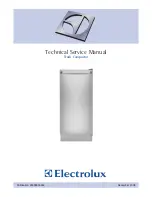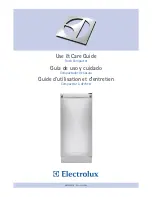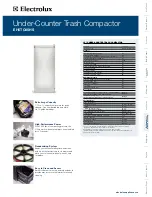
21
SERVICE AND MAINTENANCE
5.
When the oil finishes
draining, wipe the
filter base and apply a
thin coat of fresh oil on
the new filter base.
6.
Install the new filter.
7.
Re-install the filter
guard.
8.
Remove the top port
plug (d) from the
transaxles to allow
the transaxles to vent
during filling. See
Figure 39.
9.
Using a high-quality
20W50 motor oil,
slowly fill the transaxles until oil appears at the top port on the transaxles.
10.
Re-install the top port plugs. Torque to 180 in-lbs (20.3 N-m). and continue
to fill until the “FULL COLD” line is reached.
11.
Replace the reservoir cap and fully tighten.
12.
Repeat the process for the other transmission.
13.
When replacing the transmission oil, a “purging” procedure should be
performed to remove air form the system. The procedure should be
performed with the rear wheels off the ground or in an area free of
bystanders or objects. To perform the purging procedure:
a.
Disengage the brake and open the bypass valves and start the
tractor.
b.
Move the lapbars in forward and reverse 5-6 times slowly.
c.
Close the bypass valves.
d.
Move the lapbars in forward and reverse 5-6 times slowly.
e.
Check the oil level and add as necessary.
f.
Repeat steps a-e until the transaxles operate at normal noise levels
and normal speeds.
Off-Season Storage
If your tractor is not going to be operated for an extended period of time (thirty
days or more), the tractor should be prepared for storage. Store the tractor in a dry
and protected location. If stored outside, cover the tractor (including the tires) to
protect it from the elements. The procedures outlined below should be performed
whenever the tractor is placed in storage.
1.
Change the engine oil and filter following the instructions provided in this
manual as well as the engine manual packed with this tractor.
WARNING
Never store the tractor with fuel in the tank indoors or in poorly ventilated
enclosures, where fuel fumes may reach an open flame, spark or pilot light as
on a furnace, water heater, clothes dryer, etc.
2.
If storing the tractor for 30 days or more:
a.
To prevent gum deposits from forming inside the engine’s carburetor
and causing possible malfunction of the engine, the fuel system
must be either completely emptied, or the gasoline must be treated
with a stabilizer to prevent deterioration.
b.
Using a fuel stabilizer for storage between 30 and 90 days:
•
Read the product manufacturer’s instructions and
recommendations.
•
Add to clean, fresh gasoline the correct amount of stabilizer
for the capacity (approximately 5 gallons) of the fuel system.
•
Fill the fuel tank with treated fuel and run the engine for 2-3
minutes to get stabilized fuel into the carburetor.
•
Fuel left in the fuel tank deteriorates and will cause serious
starting problems.
(c)
(a)
(a)
(a)
(b)
(d)
Figure 39
c.
Emptying the fuel system for storage of more than 90 days:
•
Prior to putting the tractor in storage, monitor fuel
consumption with the goal of running the fuel tank empty.
•
Run the engine until it begins to stall. Use the choke to keep
the engine running until all fuel in the carburetor has been
exhausted.
•
Referring to the engine manual, drain the fuel from the
carburetor bowl.
3.
Clean the engine and the entire tractor thoroughly.
Note:
Using a pressure washer or garden hose is not recommended for cleaning
your tractor other than to clean the underside of the deck. It may cause damage to
electrical components, spindles, pulleys, bearings or the engine. The use of water
will result in shortened life and reduce serviceability.
4.
Fully charge the battery, then disconnect the negative cable at the battery
to prevent possible discharge. Recharge the battery periodically when in
storage.
Note:
Remove the battery if exposed to prolonged periods of sub-freezing
temperatures. Store in a cool, dry location where temperatures are above freezing.
5.
Lubricate all lubrication points.
Removing The Tractor From Storage
1.
Check the engine oil.
2.
Fully charge the battery and inflate the tires to the recommended pressure.
See tire side wall for proper tire inflation pressure.
3.
Fill the fuel tank with clean, fresh gasoline.
4.
Start the engine and allow to idle for a few minutes to ensure engine is operating
properly.
5.
Drive the tractor without a load to make certain all the tractor systems are
functioning properly.
Adjustments
Adjusting Deck Lift Pedal
The deck lift pedal can be adjusted to
operator preference.
1.
Set the deck to the transport
position.
2.
Remove the hex bolt, washer
and hex nut near the center of
the pedal assembly. See Figure
40.
3.
Position the pedal to the optimal position based
on operator preference. See Figure 41.
4.
Reinstall the hardware previously removed and
torque the nut to 28-35 ft-lbs (38-47 N-m). See
Figure 40.
Deck Leveling
If the cutting deck appears to be mowing unevenly, leveling adjustments can be
performed.
WARNING
If the tractor has been recently run, the engine, muffler and surrounding
metal surfaces will be very hot and can cause burns to the skin. Let the
engine cool for at least five minutes. Exercise caution to avoid burns.
Figure 40
Figure 41
Содержание 47RIAHA6010
Страница 79: ...NOTES ...
Страница 80: ...NOTES ...















































